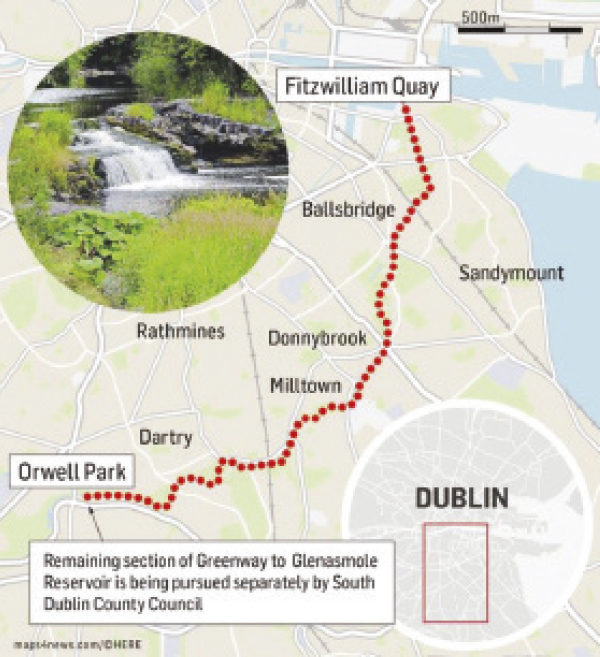
Plans were recently submitted for an eagerly-awaited development of a dual walk and cycle greenway along the River Dodder. The primary aim of the project is to alleviate continued flood damage along the banks of the Dodder while increasing local amenities. The project has been proposed since 2013 and with the increase in commuting pressures and urban congestion has recently gathered steam.
The proposed route will span three local authorities Dublin city, Dún Laoghaire-Rathdown and South Dublin and is projected to cost €22 million. The Dodder itself is a conservation zone so the ethos behind the development is to preserve, protect and enhance. Whilst there are numerous benefits to the proposal, the inner city route has proved somewhat contentious.
Most of the observations submitted to the project were of support with a small number raising concerns to which Dublin City Council and local authorities did their best to address and work with concerned parties to find solutions. DCC worked closely with residents throughout the development of the proposal to try to establish a designated route and areas where the greenway would be of most benefit. This included extending paths, bridges and other public amenities.
Whilst many were excited by these changes and the back and forth dialogue driving the project forward, the Dublin cycling community still see areas where the project could be improved upon. The community is represented largely by cyclist.ie and felt their unique perspective as a cycling community was not valued as highly as others.
The cycling community stressed that while the public was involved at various levels of development, many options and proposed layouts were removed before these consultations, limiting the public value to the process. They see the potential that if the route is executed efficiently it would greatly increase transfers from car commute to bicycle commute in the future, easing urban congestion.
The Dublin cycling communities’ main concerns revolve around poor quality shared space, unnecessary environmental impacts of the development and possible safety risks to walkers and cyclists along the route if it is shared, while completely ignoring National Cycle Manual and the Dublin City Development Plan.
The route itself is 24 kilometres in length, linking Dublin City at the mouth of the River Liffey to Bohernabreena in the Dublin Mountains. Along the route, it is noted by both the DCC and cyclist.ie that the five needs of the cyclist can not always be met but the proposal strives to where possible.
It is perhaps somewhat unrealistic that cyclist.ie find the shared space design unacceptable and are canvassing for a completely segregated cycle path. The cycling communities’ desire is for a clear high-speed cycle corridor that would greatly benefit commuters, but everyone’s needs must be taken into consideration at this early stage.
The Dodder Greenway Project was primarily a device to reduce flooding and eliminate further damage and the resulting greenway grew from a desire for the project to work harder for the entire community. A dual-use route may not be as beneficial to a particular community, but at least everyone is included in the current proposal and it is ultimately a vast improvement on what currently exists.
It is important to remember that the project is still at the consultation stage, so there is still huge scope for change. The project is not proposed to go before Dublin City Planning until early 2020, at which point all considerations will be noted and will help direct the final route. While there have been some bumps along the way, the Greenway project has the potential to be an extremely exciting addition to the fabric of Dublin.



